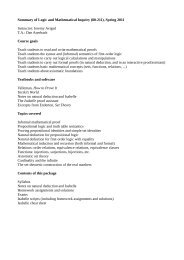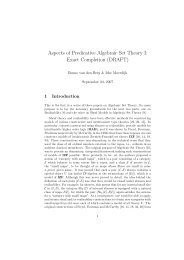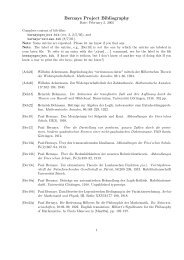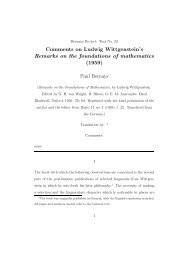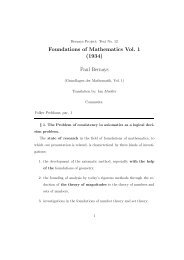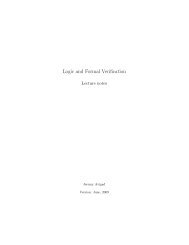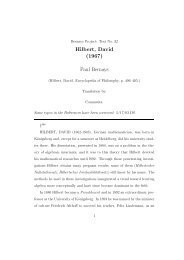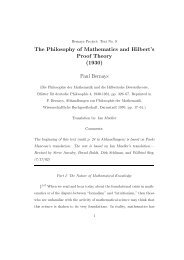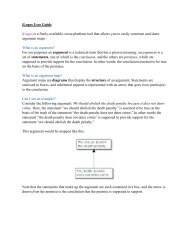Problems of Theoretical Logic (1927) Paul Bernays
Problems of Theoretical Logic (1927) Paul Bernays
Problems of Theoretical Logic (1927) Paul Bernays
Create successful ePaper yourself
Turn your PDF publications into a flip-book with our unique Google optimized e-Paper software.
<strong>Bernays</strong> Project: Text No. 5<br />
<strong>Problems</strong> <strong>of</strong> <strong>Theoretical</strong> <strong>Logic</strong><br />
(<strong>1927</strong>)<br />
<strong>Paul</strong> <strong>Bernays</strong><br />
(Probleme der theoretischen Logik, <strong>1927</strong>)<br />
Translation by: Wilfried Sieg and Sigrid Goodman<br />
Comments:<br />
Revised 6/18/02.<br />
‖ 369/A1 Lecture given at the 56th meeting <strong>of</strong> German philologists and<br />
teachers in Göttingen.<br />
The topic <strong>of</strong> the lecture and its title have been chosen in the spirit <strong>of</strong><br />
Hilbert. What is called theoretical logic here is usually referred to as symbolic<br />
logic, mathematical logic, algebra <strong>of</strong> logic, or logical calculus. The purpose<br />
<strong>of</strong> the following remarks is to present this research area in a way that justifies<br />
calling it theoretical logic.<br />
Mathematical logic is in general not very popular. It is most <strong>of</strong>ten regarded<br />
as idle play that neither supports effectively practical inference nor<br />
contributes significantly to our logical insights.<br />
First <strong>of</strong> all, the charge <strong>of</strong> playfulness is only justified in view <strong>of</strong> the initial<br />
treatment <strong>of</strong> mathematical logic. The main emphasis was initially put on<br />
1
the formal analogy to algebra, and the pursuit <strong>of</strong> the latter was <strong>of</strong>ten considered<br />
as an end in itself. But this was the state <strong>of</strong> affairs decades ago, and<br />
today the problems <strong>of</strong> mathematical logic are inseparably intertwined with<br />
the questions concerning the foundations <strong>of</strong> the exact sciences, so that one<br />
can no longer speak <strong>of</strong> a merely playful character.<br />
Secondly, concerning the application to practical inference, it has to be<br />
mentioned first that a symbolic calculus promises advantages only to someone<br />
who has sufficient practice in using it. But, in addition, one has to consider<br />
that—in contrast to most kinds <strong>of</strong> symbolisms which serve, after all, the<br />
purpose <strong>of</strong> abbreviating and contracting operations—it is the primary task<br />
<strong>of</strong> the logical calculus to decompose the inferences into their ultimate constituents<br />
and to make outwardly evident each individual step and bring it<br />
thereby into focus. The main interest connected with the application <strong>of</strong> the<br />
logical calculus is consequently not technical, but theoretical and principled.<br />
‖ A2 This leads me to the third charge; namely that mathematical logic does<br />
not significantly further our logical insights. This opinion is connected with<br />
the view on logic expressed by Kant in the second preface to the Critique<br />
<strong>of</strong> Pure Reason, where he says: “It is remarkable also that to the present<br />
day this logic has not been able to advance a single step, and is thus to all<br />
appearance a closed and completed body <strong>of</strong> doctrine.” 1<br />
It is my intention to show that this standpoint is erroneous. To be<br />
sure, Aristotle’s formulation <strong>of</strong> the ultimate principles <strong>of</strong> inference and their<br />
immediate consequences constitutes one <strong>of</strong> the most significant intellectual<br />
achievements; it is also one <strong>of</strong> the very few [achievements] which belong to<br />
1 Kant, CPR B viii=Kemp Smith, p. 17.<br />
2
the permanently secured part <strong>of</strong> the realm <strong>of</strong> philosophical knowledge. This<br />
fact will continue to be fully appreciated. But this does not prevent us from<br />
ascertaining that traditional logic, in posing its problems, is essentially openended,<br />
and in arranging its facts it is insufficiently adapted to the needs <strong>of</strong><br />
either a systematic overview and <strong>of</strong> methodical and epistemologico-critical<br />
insights. Only the newer logic, as it has developed under the name <strong>of</strong> algebra<br />
<strong>of</strong> logic or mathematical logic, introduced those concept formations and such<br />
an approach to formal logic that make it possible to satisfy these needs <strong>of</strong><br />
systematics and <strong>of</strong> philosophy.<br />
The realm <strong>of</strong> logical laws, the world <strong>of</strong> abstract relations, has only thereby<br />
been revealed to us in its formal structure, and the relationship <strong>of</strong> mathematics<br />
and logic has been illuminated in a new way. I will try briefly to give<br />
an idea <strong>of</strong> this transformation and <strong>of</strong> the results it has brought to light.<br />
In doing so I will not be concerned with presenting the historical development<br />
or the various forms in which mathematical logic has been pursued.<br />
Instead, I want to choose a presentation <strong>of</strong> the new logic that best facilitates<br />
relating and comparing it to traditional logic. As for logical symbols, I shall<br />
use the symbolism Hilbert employs now in his lectures and publications.<br />
Traditional logic subdivides its problems into the investigation <strong>of</strong> concept<br />
formation, <strong>of</strong> judgment, and <strong>of</strong> inference. It is not advantageous to begin with<br />
concept formation, because its essential ‖ 3 forms are not elementary but are<br />
already based on judgments. Let us begin, therefore, with judgment.<br />
Here, the newer logic immediately introduces an essentially new vantage<br />
point, replacing classifications by the search for elementary logical operations.<br />
One does not speak <strong>of</strong> the categorical or the hypothetical or the negative<br />
3
judgment, but <strong>of</strong> the categorical or hypothetical connexion, <strong>of</strong> negation as<br />
a logical operation. In the same way, one does not classify judgments into<br />
universal and particular ones but introduces logical operators for universality<br />
and particularity.<br />
This approach is more appropriate than that <strong>of</strong> classification for the following<br />
reason. In judgments different logical processes generally occur in<br />
combination, so that a unique characterization according to the former is<br />
not possible at all.<br />
First let us consider the categorical relationship, i.e. that <strong>of</strong> subject and<br />
predicate. We have here an object and a proposition about it. The symbolic<br />
representation for this is<br />
P (x),<br />
to be read as:<br />
“x has the property P.”<br />
The relation <strong>of</strong> the predicate to an object is here explicitly brought out by<br />
the variable. This is merely a clearer kind <strong>of</strong> notation; however, the remark<br />
that several objects can be subjects <strong>of</strong> a proposition is crucial. In that case<br />
one speaks <strong>of</strong> a relation between several objects. The notation for this is<br />
R(x, y), or R(x, y, z), etc.<br />
Cases and prepositions are used in ordinary language to indicate the<br />
different members <strong>of</strong> relations.<br />
By taking into account relations, logic is extended in an essential way<br />
when compared with its traditional form. I shall speak about the significance<br />
<strong>of</strong> this extension when discussing the theory <strong>of</strong> inference.<br />
4
The forms <strong>of</strong> universality and particularity are based on the categorical<br />
relationship. Universality is represented symbolically by<br />
(x)P (x)<br />
“all x have the property P .”<br />
The variable x appears here as a “bound variable;” the proposition does<br />
not depend on x—in the same way as the value <strong>of</strong> an integral does not depend<br />
on the variable <strong>of</strong> integration.<br />
We sharpen the particular judgment first ‖ 4 by replacing the somewhat<br />
indefinite proposition, “some x have the property P ,” with the existential<br />
judgment:<br />
“there is an x with the property P ,”<br />
written symbolically:<br />
(Ex)P (x).<br />
By adding negation, the four types <strong>of</strong> judgment are obtained which are<br />
denoted in Aristotelian logic by the letters “a, e, i, o”.<br />
If we represent negation by putting a bar over the expression to be<br />
negated, then we obtain the following representations for the four types <strong>of</strong><br />
judgment:<br />
a: (x) P (x)<br />
e: (x) P (x)<br />
i: (Ex) P (x)<br />
o: (Ex) P (x).<br />
5
Already here, in the doctrine <strong>of</strong> “oppositions,” it proves useful for the<br />
comprehension <strong>of</strong> matters to separate the operations; thus we recognize, for<br />
example, that the difference between contradictory and contrary opposition<br />
lies in the fact that in the former case the whole proposition, e.g., (x)P (x),<br />
is negated, whereas in the latter case only the predicate P (x) is negated.<br />
Let us now turn to the hypothetical relationship.<br />
A → B<br />
“if A, then B.”<br />
This includes a connexion <strong>of</strong> two propositions (predications). So the<br />
members <strong>of</strong> this connexion already have the form <strong>of</strong> propositions, and the<br />
hypothetical relationship applies to these propositions as undivided units.<br />
The latter already holds also for the negation A.<br />
There are still other such propositional connexions, in particular:<br />
the fact that A exists together with B: A & B,<br />
and further, the disjunctive connexion; there we have to distinguish between<br />
the exclusive “or,” in the sense <strong>of</strong> the Latin “aut-aut”, and the “or” in the<br />
sense <strong>of</strong> “vel”. In accordance with Russell’s notation this latter connexion is<br />
represented by A ∨ B.<br />
In ordinary language, such connexions are expressed with the help <strong>of</strong><br />
conjunctions.<br />
A consideration, analogous to that used in the doctrine <strong>of</strong> opposition,<br />
suggests itself here, namely to combine the binary propositional connexions<br />
with negation in one <strong>of</strong> two ways, either by negating the individual members<br />
<strong>of</strong> the connexion or ‖ 5 by negating the latter as a whole. And now, let us<br />
see what dependency relations result.<br />
6
To indicate that two connexions have materially the same meaning (or<br />
are “equivalent”), I will write “eq” between them (though, “eq” is not a sign<br />
<strong>of</strong> our logical symbolism).<br />
In particular the following connexions and equivalences result:<br />
A & B: “neither A nor B”<br />
A & B: “A and B exclude each other”<br />
A & B eq A ∨ B<br />
eq A → B<br />
eq B → A<br />
A → B eq A ∨ B<br />
B eq B<br />
(double negation is equivalent to affirmation).<br />
From this it furthermore follows:<br />
A → B eq A & B<br />
eq A ∨ B<br />
A ∨ B eq A → B<br />
eq A & B.<br />
On the basis <strong>of</strong> these equivalences it is possible to express some <strong>of</strong> the<br />
logical connexions<br />
, →, &, ∨<br />
by means <strong>of</strong> others. In fact, according to the above equivalences one can<br />
express<br />
→ by ∨ and<br />
∨ by & and<br />
& by → and<br />
7
so that each <strong>of</strong><br />
or<br />
or<br />
& and<br />
∨ and<br />
→ and<br />
alone suffice as basic connexions. One can get along even with a single basic<br />
connexion, but, to be sure, not with one <strong>of</strong> those for which we already have a<br />
sign. If we introduce for the connexion <strong>of</strong> mutual exclusion A & B the sign<br />
A|B<br />
then the following equivalences obtain:<br />
A|A eq A<br />
A|B eq A & B<br />
eq A → B.<br />
‖ 6 This shows that with the aid <strong>of</strong> this connexion one can represent negation<br />
as well as → and, consequently, the remaining connexions. Just like the<br />
relation <strong>of</strong> mutual exclusion also the connexion<br />
“neither — nor”<br />
A & B<br />
can be taken as the only basic connexion. If for this connexion we write<br />
A ‖ B,<br />
then we have<br />
A ‖ A eq A<br />
A ‖ B eq A & B;<br />
8
thus, negation as well as & is expressible by means <strong>of</strong> this connexion.<br />
Somehow these reflections border already on the playful. Nevertheless, it<br />
is remarkable that the discovery <strong>of</strong> such a simple fact as that <strong>of</strong> reducing all<br />
propositional connexions to a single one was reserved for the 20th century.<br />
The equivalences between propositional connexions were not at all systematically<br />
investigated in the old logic. 2 There one finds only occasional remarks<br />
like, for example, that <strong>of</strong> the equivalence <strong>of</strong><br />
A → B and B → A<br />
on which the inference by “contraposition” is based. The systematic search<br />
for equivalences is, however, all the more rewarding as one reaches here a<br />
self-contained and entirely surveyable part <strong>of</strong> logic, the so-called propositional<br />
calculus. I will explain in some detail the value <strong>of</strong> this calculus for reasoning.<br />
Let us reflect on what the sense <strong>of</strong> equivalence is. When I say<br />
A & B eq A ∨ B,<br />
I do not claim that the two complex propositions have the same sense but only<br />
that they have the same truth value. That is, no matter how the individual<br />
2 Today these historical remarks stand in need <strong>of</strong> correction. In the first place, the<br />
reducibility <strong>of</strong> all propositional connexions to a single one was already discovered in the<br />
19th century by Charles S. Peirce—to be sure, a fact which became more generally known<br />
only with the publication <strong>of</strong> his collected works in 1933. Further, it is not correct that the<br />
equivalences between propositional connectives were not considered systematically in the<br />
old logic—to be sure, not in Aristotelian logic, but in other Greek schools <strong>of</strong> philosophy.<br />
(On this topic see Bochenski’s book Formal <strong>Logic</strong> [Editorial footnote: REFERENCE?].)<br />
Remark: This footnote, as well as the next three, are subsequent additions occasioned<br />
by the republication <strong>of</strong> this lecture.<br />
9
propositions A, B are chosen, A ∨ B and A & B are always simultaneously<br />
true or false, and consequently these two expressions can represent each other<br />
with respect to truth.<br />
Indeed, any complex proposition A and B can be viewed as a mathematical<br />
function assigning to each pair <strong>of</strong> propositions A, B one <strong>of</strong> the values<br />
“true” or “false.” The actual content <strong>of</strong> the propositions A, B does not matter<br />
at all. Rather, what matters is only whether A is true or false and whether<br />
B is true or false. So we are dealing with truth functions: To a pair <strong>of</strong> truth<br />
values another truth value is assigned.<br />
Each such function can be given by a schema in such a way, that the four<br />
possible connections <strong>of</strong> two truth values (corresponding to the propositions<br />
A, B) are represented by four cells, and in each <strong>of</strong> these the corresponding<br />
truth value <strong>of</strong> the function (“true” or “false”) is written down.<br />
The schemata for A & B, A ∨ B, A → B are specified here.<br />
A & B :<br />
A<br />
{ }} {<br />
B true false<br />
{ }} {<br />
true true false<br />
false false false<br />
A ∨ B :<br />
A<br />
{ }} {<br />
B true false<br />
{ }} {<br />
true true true<br />
false true false<br />
10
A → B :<br />
A<br />
{ }} {<br />
B true false<br />
{ }} {<br />
true true true<br />
false false true<br />
‖ 8 One can easily calculate that there are exactly 16 different such functions.<br />
The number <strong>of</strong> different functions <strong>of</strong> n truth values<br />
A 1 , A 2 , . . . , A n<br />
is, correspondingly, 2 (2n) .<br />
To each function <strong>of</strong> two or more truth values corresponds a class <strong>of</strong> substitutable<br />
3 propositions <strong>of</strong> connexions. Among these one class is distinguished,<br />
namely the class formed by those connexions that are always true.<br />
These connexions represent all logical sentences that hold generally and<br />
in which individual propositions occur only as undivided units. 4 We will call<br />
the expressions representing sentences that hold generally valid formulas.<br />
We master propositional logic, if we know the valid formulas (among the<br />
propositions <strong>of</strong> connexions), or if we can decide for a given propositional<br />
connexion whether or not it is valid.<br />
propositional logic is formulated as follows:<br />
Certain connexions<br />
C 1 , C 2 , . . . , C k ,<br />
After all, the task for reasoning in<br />
3 Editorial footnote: “Um uns kurz ausdrücken zu können wollen wir zwei Aussagenverknüpfungen<br />
durch einander ‘ersetzbar’ nennen, wenn sie dieselbe Wahrheitsfunktion<br />
darstellen.” HB I, pp. 47–48.<br />
4 Editorial footnote: concerning allgemein gültig versus allgemeingültig<br />
11
are given; they are built up from elementary propositions A, B, . . ., and represent<br />
true sentences for a certain interpretation <strong>of</strong> the elementary propositions.<br />
The question is whether another given connexion D <strong>of</strong> these elementary<br />
propositions follows logically whenever C 1 , C 2 , . . . , C k are valid, indeed<br />
without considering the more precise content <strong>of</strong> the propositions A, B, . . ..<br />
The answer to this question is “yes,” if and only if<br />
(C 1 & C 2 & . . . & C k ) → D,<br />
composed from A, B, . . ., represents a valid formula.<br />
The decision concerning the validity <strong>of</strong> a propositional connexion can in<br />
principle always be reached by trying out all relevant truth values. The<br />
method <strong>of</strong> considering equivalences, however, provides a more convenient<br />
procedure. That is to say, by means <strong>of</strong> equivalent transformations each formula<br />
can be put into a certain normal form in which only the logical symbols<br />
&, ∨, occur, and from this normal form one can read <strong>of</strong>f directly whether<br />
or not the formula is valid.<br />
The rules <strong>of</strong> transformation are also very simple. One can in particular<br />
calculate with & and ∨ in complete analogy to + and · in algebra. Indeed,<br />
matters are here even simpler, as & and ∨ can be treated in a completely<br />
symmetrical way.<br />
‖ 9 By considering the equivalences, we entered, as already mentioned,<br />
the domain <strong>of</strong> inferences. But we made inferences here in a naive way, so to<br />
speak, on the basis <strong>of</strong> the meaning <strong>of</strong> the logical connexions, and we turned<br />
the task <strong>of</strong> making inferences into a decision problem.<br />
But for logic there remains the task <strong>of</strong> systematically presenting the rules<br />
<strong>of</strong> inference.<br />
12
Aristotelian logic lays down the following principles <strong>of</strong> inference:<br />
1. Rule <strong>of</strong> categorical inference: the “dictum de omni et nullo”: what<br />
holds universally, holds in each particular instance.<br />
2. Rule <strong>of</strong> hypothetical inference: if the antecedent is given, then the<br />
consequent is given, i.e. if A and if A → B, then B.<br />
3. Laws <strong>of</strong> negation: law <strong>of</strong> contradiction and law <strong>of</strong> excluded middle: A<br />
and A can not both hold, and, at least one <strong>of</strong> the two propositions must<br />
hold.<br />
4. Rule <strong>of</strong> disjunctive inference: if at least one <strong>of</strong> A or B holds and if<br />
A → C as well as B → C, then C holds.<br />
One can say that each <strong>of</strong> these laws represents the implicit definition for<br />
a logical process: 1. for universality, 2. for the hypothetical connexion, 3.<br />
for negation, 4. for disjunction (∨).<br />
These laws contain indeed the essence <strong>of</strong> what is expressed when inferences<br />
are being made. But for a complete analysis <strong>of</strong> inferences this does not<br />
suffice. For this we demand that nothing needs to be reflected upon, once<br />
the principles <strong>of</strong> inference have been spelled out. The rules <strong>of</strong> inference must<br />
be constituted in such a way that they eliminate logical thinking. Otherwise<br />
we would have to have again logical rules which specify how to apply those<br />
rules.<br />
This demand to exorcise the mind can indeed be met. The development <strong>of</strong><br />
the doctrine <strong>of</strong> inferences obtained in this way is analogous to the axiomatic<br />
development <strong>of</strong> a theory. Certain logical laws written down as formulas correspond<br />
here to the axioms, and operating [on formulas] externally according<br />
13
to fixed rules, that lead from the initial formulas to further ones, corresponds<br />
to contentual reasoning that usually leads from axioms to theorems.<br />
Each formula, that can be derived in such a way, represents a valid logical<br />
proposition.<br />
Here, it is once again advisable to separate out propositional logic, which<br />
rests on the ‖ 10 principles 2., 3., and 4. We need only the following rules,<br />
when representing the elementary propositions by variables<br />
X, Y, . . .<br />
The first rule states now: any propositional connexion can be substituted for<br />
such variables (substitution rule).<br />
The second rule is the inference schema<br />
S<br />
S → T<br />
T<br />
according to which the formula T is obtained from two formulas S, S → T.<br />
The choice <strong>of</strong> the initial formulas can be made in quite different ways.<br />
One has taken great pains, in particular, to get by with the smallest possible<br />
number <strong>of</strong> axioms, and in this respect the limit <strong>of</strong> what is possible has indeed<br />
been reached. The purpose <strong>of</strong> logical investigations is better served, however,<br />
when we separate, as in the axiomatics for geometry, various groups <strong>of</strong> axioms<br />
from one another, such that each group gives expression to the role <strong>of</strong> one<br />
logical operation. The following list then emerges:<br />
14
I<br />
Axioms <strong>of</strong> implication<br />
II a) Axioms for &<br />
II b) Axioms for ∨<br />
III<br />
Axioms <strong>of</strong> negation.<br />
This system <strong>of</strong> axioms 5 generates through application <strong>of</strong> the rules all valid<br />
formulas <strong>of</strong> propositional logic. 6 This completeness <strong>of</strong> the axiom system can<br />
be characterized even more sharply by the following facts: if we add any<br />
underivable formula to the axioms, then we can deduce with the help <strong>of</strong> the<br />
rules arbitrary propositional formulas.<br />
The division <strong>of</strong> the axioms into groups has a particular advantage, as it<br />
allows one to separate out positive logic. We understand this to be the system<br />
<strong>of</strong> those propositional connexions that are valid without assuming that an<br />
opposite exists. 7 For example:<br />
(A & B) → A<br />
(A & (A → B)) → B.<br />
‖ 11 The system <strong>of</strong> these formulas presents itself in our axiomatics as the<br />
totality <strong>of</strong> those formulas that are derivable without using axiom group III.<br />
5 Editorial footnote: fixing the axioms as in HB I, p. 65; already formulated in the early<br />
twenties As to completeness, cf. the Habilitationsschrift <strong>of</strong> <strong>Bernays</strong> written in 1918.<br />
6 We refer here only to those formulas that can be built up with the operations →, &, ∨<br />
and with negation. If further operation symbols are added, then they can be introduced<br />
by replacement rules.<br />
To be sure, one is not bound to distinguish the four mentioned<br />
operations in this particular way.<br />
7 Editorial footnote: “Die “positive Logik” . . . d.h. die Formalisierung derjenigen logischen<br />
Schlüsse, welche unabhängig sind von der Voraussetzung, daß zu jeder Aussage ein<br />
Gegenteil existiert.” HB I, p. 67.<br />
15
This system is far less perspicuous than the full system <strong>of</strong> valid formulas.<br />
Also, no decision procedure is known by which one can determine in accordance<br />
with a definite rule, whether a formula belongs to this system. 8 It is<br />
not the case that, for instance, every formula expressible in terms <strong>of</strong> →, &, ∨,<br />
which is valid and therefore derivable on the basis <strong>of</strong> I–III, is already derivable<br />
from I–II. One can rigorously prove that this is not the case.<br />
An example is provided by the formula<br />
A ∨ (A → B).<br />
Representing → by ∨ and<br />
this formula turns into<br />
A ∨ (A ∨ B),<br />
and this representation allows one immediately to recognize the formula as<br />
valid. However, it can be shown that the formula is not derivable within<br />
positive logic, i.e., on the basis <strong>of</strong> axioms I–II. Hence, it does not represent<br />
a law <strong>of</strong> positive logic.<br />
We recognize here quite clearly that negation plays the role <strong>of</strong> an ideal element<br />
whose introduction aims at rounding <strong>of</strong>f the logical system to a totality<br />
with a simpler structure, just as the system <strong>of</strong> real numbers is extended to<br />
a more perspicuous totality by the introduction <strong>of</strong> imaginary numbers, and<br />
just as the ordinary plane is completed to a manifold with a simpler projective<br />
structure by the addition <strong>of</strong> points at infinity. Thus this method <strong>of</strong> ideal<br />
elements, fundamental to science, is already encountered here in logic, even<br />
if we are usually not aware <strong>of</strong> its significance.<br />
8 Since then decision procedures for positive logic have been given by Gerhard Gentzen<br />
and Mordechaj Wajsberg.<br />
16
A special part <strong>of</strong> positive logic is constituted by the doctrine <strong>of</strong> chain<br />
inferences/sorites that was discussed already in Aristotelian logic. In<br />
this area there are also natural problems and simple results, not known to<br />
traditional logic and again requiring that specifically mathematical considerations<br />
be brought to bear. I have in mind <strong>Paul</strong> Hertz’s investigations <strong>of</strong><br />
sentence-systems. — 9<br />
The hitherto existing axiomatics refers to those inferences which depend<br />
solely on the rules <strong>of</strong> the hypothetical and disjunctive inference, ‖ 12 and <strong>of</strong><br />
negation. Now we still have the task <strong>of</strong> incorporating categorical reasoning<br />
into our axiomatics. How this is done I will only describe briefly here.<br />
Of the dictum de omni et nullo we need also the converse: “what holds<br />
in each particular instance, also holds generally.” Furthermore, we have to<br />
take into account the particular judgment. It holds analogously:<br />
“If a proposition A(x) is true <strong>of</strong> some object x, then there is an object <strong>of</strong><br />
which it is true, and vice versa.”<br />
Thus we obtain four principles <strong>of</strong> reasoning that are represented in the<br />
axiomatics by two new initial formulas and two rules. A substitution rule for<br />
the individual variables x, y, . . . is also added.<br />
Moreover, the substitution rule concerning propositional variables X, Y, . . .<br />
has to be extended in such a way now that the formulas <strong>of</strong> propositional logic<br />
can be applied also to expressions containing individual variables.<br />
Let us see now, how the typical Aristotelian inferences are worked out<br />
from this standpoint. For that it is necessary to say first something about<br />
the interpretation <strong>of</strong> the universal judgment “all S are P ”.<br />
9 Editorial footnote: ref. to HB I, p. 84, but also Keynes, p. 300.<br />
17
According to the Aristotelian view, such a judgment presupposes that<br />
there are certain objects with property S, and it is then claimed that all<br />
these objects have property P . This interpretation <strong>of</strong> the universal judgment,<br />
to which Franz Brentano in particular objected from the side <strong>of</strong> philosophy,<br />
is admittedly quite correct. But it is suited neither for the purposes<br />
<strong>of</strong> theoretical science nor for the formalization <strong>of</strong> logic, since the implicit<br />
presupposition brings with it unnecessary complications. Therefore we shall<br />
restrict the content <strong>of</strong> the judgment, “all S are P ,” to the assertion, “an<br />
object having property S has also property P .”<br />
Accordingly, such a judgment is simultaneously universal and hypothetical.<br />
It is represented in the form<br />
(x)(S(x) → P (x)).<br />
The so-called categorical inferences contain consequently a combination <strong>of</strong><br />
categorical and hypothetical inferences. I want to illustrate this by a classical<br />
example:<br />
“All men are mortal, Cajus is a man, therefore Cajus is mortal.”<br />
If we represent “x is ‖ 13 human” and “x is mortal” in our notation by<br />
H(x) and M(x) respectively, then the premises are<br />
(x)(H(x) → M(x)),<br />
H(Cajus),<br />
and the conclusion is: M(Cajus).<br />
The derivation proceeds, first, according to the inference from the general<br />
to the particular, by deducing from<br />
(x)(H(x) → M(x))<br />
18
the formula<br />
H(Cajus) → M(Cajus).<br />
And this proposition together with<br />
H(Cajus)<br />
yields according to the schema <strong>of</strong> the hypothetical inference:<br />
M(Cajus).<br />
It is characteristic for this representation <strong>of</strong> the inference that one refrains<br />
from giving a quantitative interpretation <strong>of</strong> the categorical judgment (in the<br />
sense <strong>of</strong> subsumption). Here one recognizes particularly clearly that mathematical<br />
logic does not depend in the least upon being a logic <strong>of</strong> extensions.<br />
Our rules and initial formulas permit us now to derive all the familiar<br />
Aristotelian inferences as long as they agree with our interpretation <strong>of</strong> the<br />
universal judgment—that leaves just 15. In doing so one realizes that there<br />
are actually only very few genuinely different kinds <strong>of</strong> inferences. Furthermore,<br />
one gets the impression that the underlying problem is delimited in a<br />
quite arbitrary way.<br />
A more general problem, which is also solved in mathematical logic, consists<br />
in finding a decision procedure that allows one to determine whether<br />
a predicate formula is valid or not. In this way, one masters reasoning in<br />
the domain <strong>of</strong> predicates, just as one masters propositional logic with the<br />
decision procedure mentioned earlier.<br />
But our rules <strong>of</strong> inference extend much farther. The actual wealth <strong>of</strong> logical<br />
connections is revealed only when we consider relations (predicates with<br />
19
several subjects). Only then does it become possible to capture mathematical<br />
pro<strong>of</strong>s in a fully logical way.<br />
However, here one is induced to add various extensions which are suggested<br />
to us also by ordinary language.<br />
The first extension consists in introducing a formal expression for “x is<br />
the same object as y,” or “an object different from y.” For this purpose the<br />
“identity <strong>of</strong> x and y” has to be formally represented as a particular relation,<br />
the properties <strong>of</strong> which are to be formulated as axioms.<br />
Second, we need a symbolic representation <strong>of</strong> the logical relation we express<br />
linguistically with the aid <strong>of</strong> the genitive or the relative pronoun in<br />
such phrases as “the son <strong>of</strong> Mr. X” or “the object that.” This relation forms<br />
the basis <strong>of</strong> the concept <strong>of</strong> a function in mathematics. It matters here that<br />
an object, having uniquely a certain property or satisfying a certain relation<br />
to particular objects, is characterized by this property or relation.<br />
The most significant extension, however, is brought about by the circumstance<br />
that we are led to consider predicates and relations themselves<br />
as objects, just as we do in ordinary language when we say, for example,<br />
“patience is a virtue.” We can state properties <strong>of</strong> predicates and relations,<br />
and furthermore, [second order] relations between predicates and also between<br />
relations. Likewise, the forms <strong>of</strong> universality and particularity can be<br />
applied with respect to predicates and relations. In this way we arrive at a<br />
logic <strong>of</strong> “second order;” for its formal implementation the laws <strong>of</strong> categorical<br />
reasoning have to be extended appropriately to the domain <strong>of</strong> predicates and<br />
relations.<br />
The solution <strong>of</strong> the decision problem—which, incidentally, is here auto-<br />
20
matically subsumed under a more general problem—presents an enormous<br />
task for this enlarged range <strong>of</strong> logical relation resulting from the inclusion <strong>of</strong><br />
relations and the other extensions mentioned. Its solution would mean that<br />
we have a method that permits us, at least in principle, to decide for any<br />
given mathematical proposition whether or not it is provable from a given<br />
list <strong>of</strong> axioms. As a matter <strong>of</strong> fact, we are far from having a solution <strong>of</strong> this<br />
problem. Nevertheless, several important results <strong>of</strong> a very general character<br />
have been obtained in this area through the investigations <strong>of</strong> Löwenheim<br />
and Behmann; in particular one succeeded in completely solving the decision<br />
problem for predicate logic also in the case <strong>of</strong> second order logic. 10<br />
‖ 15 Here we see that the traditional doctrine <strong>of</strong> inferences comprises only<br />
a minute part <strong>of</strong> what really belongs to the domain <strong>of</strong> logical inference.<br />
As yet I have not even mentioned concept formation. And, for lack <strong>of</strong> time,<br />
I cannot consider it in detail. I will just say this much: a truly penetrating<br />
logical analysis <strong>of</strong> concept formation becomes possible only on the basis <strong>of</strong><br />
the theory <strong>of</strong> relations. Only by means <strong>of</strong> this theory one realizes what<br />
kind <strong>of</strong> complicated combinations <strong>of</strong> logical expressions (relations, existential<br />
propositions, etc.) are concealed by short expressions <strong>of</strong> ordinary language.<br />
Such an analysis <strong>of</strong> concept formation has been initiated to a large extent,<br />
especially by Bertrand Russell, and it has led to knowledge about general<br />
logical processes <strong>of</strong> concept formation. The methodical understanding <strong>of</strong><br />
science is being furthered considerably through their clarification.<br />
10 Notice that one speaks here <strong>of</strong> “predicate logic” in the sense <strong>of</strong> the distinction between<br />
predicates and relations. Thus, what is meant here by “predicate logic” is what currently<br />
is mostly called the logic <strong>of</strong> monadic predicates. The logic <strong>of</strong> polyadic predicates is already<br />
generally undecidable for the first order case, as was shown by Alonzo Church.<br />
21
I now come to the end <strong>of</strong> my remarks. I have tried to show that logic,<br />
that is to say the correct old logic as it was always intended, obtains its genuine<br />
rounding <strong>of</strong>f, its proper development and systematic completion, only<br />
through its mathematical treatment. The mathematical mode <strong>of</strong> consideration<br />
is introduced here not artificially, but rather arises in an entirely natural<br />
way, when problems are being pursued further.<br />
The resistance to mathematical logic is widespread, particularly among<br />
philosophers; it has—apart from the reasons mentioned at the beginning—<br />
also a principled one. Many approve <strong>of</strong> having mathematics absorbed into<br />
logic. But here one realizes the opposite, namely, that the system <strong>of</strong> logic is<br />
absorbed into mathematics.<br />
With respect to the mathematical formalism logic appears here as a<br />
specific interpretation and application, perfectly resembling the relation between,<br />
for example, the theory <strong>of</strong> electricity and mathematical analysis, when<br />
the former is treated according to Maxwell’s theory.<br />
That does not contradict the generality <strong>of</strong> logic, but rather the view that<br />
this generality is superordinate to that <strong>of</strong> mathematics. <strong>Logic</strong> is about certain<br />
contents that find application to any subject matter whatsoever, ins<strong>of</strong>ar as<br />
it is thought about. Mathematics, on the other hand, is about the most<br />
general laws <strong>of</strong> any ‖ 16 combination whatsoever. This is also a kind <strong>of</strong><br />
highest generality, namely, in the direction towards the formal. Just as every<br />
thought, including the mathematical ones, is subordinate to the laws <strong>of</strong> logic,<br />
each structure, each manifold however primitive—and thus also the manifold<br />
given by the combination <strong>of</strong> sentences or parts <strong>of</strong> sentences—must be subject<br />
to mathematical laws.<br />
22
If we wanted a logic free <strong>of</strong> mathematics, no theory at all would be left,<br />
but only pure reflection on the most simple connections <strong>of</strong> meaning. Such<br />
purely contentual considerations—which can be comprised under the name<br />
“philosophical logic”—are, in fact, indispensable and decisive as a starting<br />
point for the logical theory; just as the purely physical considerations, serving<br />
as the starting point for a physical theory, constitute the fundamental<br />
intellectual achievement for that theory. But such considerations do not constitute<br />
fully the theory itself. Its development requires the mathematical<br />
formalism. Exact systematic theory <strong>of</strong> a subject is, for sure, mathematical<br />
treatment, and it is in this sense that Hilbert’s dictum holds: “Anything at<br />
all that can be the object <strong>of</strong> scientific thought, as soon as it is ripe for the<br />
formation <strong>of</strong> a theory. . . will be part <strong>of</strong> mathematics.” 11 Even logic can not<br />
escape this fate.<br />
11 Editorial footnote on Hilbert source.<br />
23



